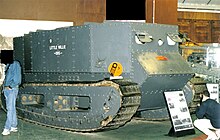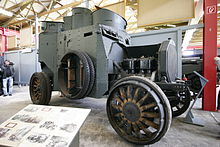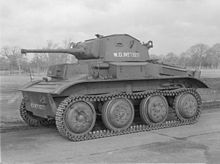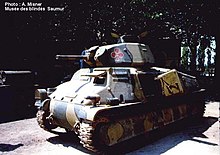Tanks (1914-1933)
At the beginning of the First World War , neither side involved had large motorized units. Armored automobiles were occasionally used, for example the French autoblindé Peugeot . Relatively extensive use of armored cars and armored vehicles such as the Austin-Putilow was noted on the Russian side from 1915 . However, these vehicles were road-bound and not intended for operations on the battlefield. They lacked cross-country mobility and firepower. Vehicles equipped with full tracks such as the Holt Caterpillar were available, but only served as a tractor for heavy artillery . They seldom got closer than 15 km to the front line. They were not intended to be used as weapons carriers.
Early developments
Since the Western Front had frozen in trench warfare in the autumn of 1914 , there was no effective means of breaking through the opposing defense and returning to war of movement . Even for infantrymen, the way through the no man's land was made almost impossible. Barbed wire- reinforced trench systems hampered progress, and a constant threat from snipers, machine gun nests and artillery fire made even leaving one's cover dangerous to life.
Although there were some drafts and prototypes of armored vehicles before the start of the war, these were rejected by the respective military leadership. Only when conventional tactics no longer worked during the war did people become open to new ideas.
On the British side, Lt. Col. Ernest Swinton and Maurice Hankey , Secretary of the British National Defense Council, gave initial consideration to developing an armored tracked vehicle . Appropriately armored and armed, the vehicle was to serve as a machine-gun destroyer and enable a renewed transition to warfare on the move. Swinton managed to get a demonstration of his first designs on February 17, 1915. It had rained heavily that day. The Holt Caterpillar was supposed to pull a truck loaded with 2.5 tons of sand through the sodden terrain. This weight was intended to simulate the armor and armament of the future tank. The device failed. The fact that it makes a difference whether the weight is on the vehicle itself or has to be pulled was ignored at the time. One of those in attendance was then First Lord of the Admiralty Winston Churchill . He expected a lot from the experiments and supported Swinton. In his eyes, the "land ships" were an effective means of winning the war. Thanks to Churchill's tenacity, further trials were commissioned on September 29, 1915. Finally, the engineers revised the design of the Holt Caterpillar to meet the technical specifications of the War Department. The tank should have a trench crossing ability of 2.50 m and a 45 ° gradient.
A corresponding development order was given to Foster on July 24, 1915. After various preliminary investigations, Tritton and Wilson, the chief designers of the Foster company, began building a prototype on August 11, 1915, which later became known as the "Tritton" tank. After considerable changes and improvements, the Little Willie emerged (14 t weight, 5 men crew, top speed 5.5 km / h and off-road 2 km / h). This should get on his box-like structure nor a turret with a 2-pounder cannon, but was totally unfit for service in the field: The silhouette was far too high and required overcoming 2.5 m wide trenches would focus far too high been. Tritton therefore quickly dropped this idea and closed the tower opening with a riveted plate. From then on, the “Little Willie” was only used for driver training and for testing the crawler tracks for a new tank: These crawlers were rightly recognized as the weak point of the entire upcoming development. Meanwhile, Wilson turned to a completely new concept: The caterpillar track was to wrap around a rhombus-shaped housing and two 6-pounder cannons were to be attached to the side: this resulted in a low center of gravity and good trench crossing ability. The prototype of the Mark I , the Big Willie, was born. The vehicle was 9.90 m long and weighed 28 t. The armor was a maximum of 10 mm.
The name "Tank" was chosen for reasons of secrecy : the weapon was brand new and was classified as "possibly decisive for the war" and therefore as "top secret". In order to largely divert attention from the original topic of "armored vehicles", curious questions: "What are you working on" were answered simply with "working on a tank" (i.e. a container for liquids). In fact, the shell of the first British tanks with no cannon or chain looked more like a tank than a new weapon. After the first appearance of British tanks on the battlefield, it was no longer necessary on the German side to use other names than the actual ones: Panzerkampfwagen and, as an abbreviation, simply tanks . In the English-speaking world, the term tank has survived to this day .
First British tank
In 1916, the first Panzer Mark I battle tanks appeared. They were divided into “Male” and “Female”. The vehicles were the same; "Male" tanks had cannons with them, "female" tanks were armed only with machine guns. This concept had been adopted from "Little Willie" and "Big Willie". These tanks were rhombus-shaped and had no turret. As with warships of the time, the guns were arranged in casemates . Often been fascinated carried, in order to overcome greater obstacles or subsequent infantry to pave the way. For example, these fascines could simply be placed over barbed wire and thus formed a kind of road. Triangular “roofs” were sometimes placed on the tanks as simple protection against attacking infantry. When infantrymen threw hand grenades at the weaker armored upper section, the grenades did not stay where they were, but rolled down.
The Mark I to Mark III models were prototypes built in small numbers, but they were still used on the battlefield. The Mark IV was the first mass-produced tank. Its successor, the Mark V , was used until the 1930s. The construction was so successful that bridge layers and deminers were built from Mark V tanks, although technically superior material was already available. A smaller and more maneuverable tank was the Mark A known as the "Whippet" . It was less used for breakthroughs, but was intended to take advantage of the breakthroughs made by heavy tanks. He was the first vehicle to have the concept of the turret armor, even if the turret was not rotatable. The “Whippet” was also used for a relatively long time. In the 1920s, some Mark A were even exported to Japan .
French designs
On the French side the British efforts in the construction of the tanks were followed very closely. In contrast to the British, however, the French were able to fall back on experiences they had already made. The result was the Char d'assaut St. Chamond and the Char d'Assaut Schneider . Both chariots competed with each other and were nowhere near as sophisticated as their British counterparts. The St. Chamond tended to be top heavy. This was due to the Holt caterpillar drive used, which was much too short for the enormous total length of the St. Chamond of 8.83 meters. Both vehicles continued to suffer from their poor off-road capabilities. There was no division into “male” and “female” tanks.
The best French development of the war was the Renault FT . The vehicle is the world's first real turret tank. The fully rotating turret was armed with a 37mm cannon or a machine gun. The FT represented a breakthrough in tank development. FT even served in units of the French army during World War II , although the vehicle was hopelessly outdated at the time: It weighed 7 tons and only had 35 hp and therefore only drove a maximum of 8 off-road km / h.
French special ways
From the knowledge that the First World War brought, the French looked for gun carriers and not for battle tanks. Colonel Louis Filloux (1869–1957) developed the GPF 194 mm from these specifications . The St. Chamond 280 mm mortar was delivered from the St. Chamond plant, which also produced one of the most important tanks in France . All of this should lead to the motorization of heavy artillery. The cannons on the track drive were still very fragile and had problems with stability, but there were the first approaches for the creation of the later self-propelled artillery (" Selbstfahrlafette ").
German reaction
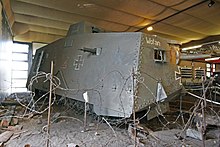
The appearance of armored vehicles of the Entente in front of the German lines prompted the leadership to quickly rethink. The General Traffic Department 7 , hence the name of the car, hastily constructed a heavy combat vehicle, the A7V . Several hundred vehicles of this type were ordered, but only twenty vehicles were delivered. The tank turned out to be a powerful and, for its time, fastest gun platform. If a British Mark IV reached a top speed of 6 km / h, the A7V already reached 16 km / h. Its driving characteristics in moderately difficult terrain were consistently good, but it got difficulties in extreme soil conditions with deep funnel fields, very wide trenches and muddy ground. The most common problems, however, were with the engine, transmission, and chain. The cars reached the front in January 1918 by the time they were operational, but another quarter of a year passed.
The A7V had by far the largest crew. 16 men were normally in the car. In combat operations, however, the number could increase to up to 26 men, including a carrier pigeon keeper with his reporting pigeons.
First successes and new tactics
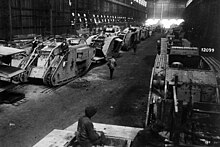
The British 4th Army carried out the first tank attack on September 15, 1916 in the Somme battle near Flers . The original plan was to use 49 Mark I tanks. However, the vehicles were still very unreliable, so that 17 pieces were already canceled on the way to the front. When the remaining tanks attacked, some of the Germans fled their trenches in a panic , the rest retreated into holes in the ground and took up the fight with stick grenades, so that only five "tanks" survived this attack.
The British tank tactics of the early days primarily provided support for the storming infantry. A closed deployment of armored formations was not considered. The tank was not yet considered an independent weapon. The occasional companions raised the morale of the storming infantry, but easily fell victim to the German artillery . A leading British general made an appraisal of the new armored vehicles:
“First, tanks are of no use in poor terrain. Second, the terrain is always bad in battle. Third, the tanks are useless on the battlefield. "
Despite such critics, the tank commanders developed new operational tactics. Based on the experience of the Third Battle of Flanders near Ypres (July 31 to November 6, 1917), it was decided to no longer use tanks in small groups, but rather in masses. So the tank could decide a battle. The tank men were supposed to prove this in Cambrai in the winter of 1917/18.
First large-scale tank deployment during the Battle of Cambrai
The Battle of Cambrai began on November 20th and ended on December 7th, 1917. According to General Douglas Haig's planning , all available British 476 tanks were used. In addition to 376 battle tanks from the three British brigades, these included armored cannon transporters, tanks with bridge building material and special tanks for the destruction of barbed wire obstacles. For the first time, the British Air Force was deployed in a coordinated battle with ground troops. The tactics worked out worked on November 20th. The tank losses were high, as almost half of the tanks were destroyed or no longer operational after the first day of the offensive, but the tank had proven its worth on the battlefield. The German front had been breached over a width of 16 kilometers and a depth of nine kilometers. The coordination of the tank and infantry units was partially inadequate. After the first breakthrough of the German lines, parts of the British infantry took a break. When the attack resumed, these infantrymen followed nearly 100 meters behind the advancing tanks. This left the infantry without armor cover and had to retreat when the German guns first struck fire. The tanks advancing alone were also easy targets for the German cannons and were put out of action one by one. Depending on the source, 4,000 to 8,000 Germans were captured and 100 guns captured on the first day of the attack. The British lost 4,000 soldiers. On the first day of the attack, 49 tanks were destroyed by direct hits by gun grenades. Many of the other tanks were badly damaged and the tracks of over 40 had come off. The German troops were now massively reinforced and further British attacks brought no major gains in territory. On November 27, the British attacks ceased and the tanks withdrawn from the front for a thorough overhaul. During the German counterattack on November 30, 1917, specially trained assault battalions or shock troops were used on a large scale for the first time by the German side according to the Hutier tactics. By December 7th, 9,000 British soldiers had been captured, 148 artillery pieces, 716 machine guns captured. More than 100, mostly damaged, British tanks were captured. At Cambrai, of the 476 tanks, more than 250 were destroyed or captured by the Germans. 50,000 soldiers on the German side and 45,000 on the British side were no longer operational after the battle due to death, capture, injury and illness.
The Battle of Cambrai had a significant impact on later German military planning. The British tactics for coordinating infantry, air and tank forces set new standards in warfare and were successfully used by the Germans in the Second World War as part of the “ Blitzkrieg ” tactic. The German military recognized the advantages of specially trained assault battalions or shock troops and the advantage of mobile troops that could be quickly moved to critical sections of the front.
First tank duel
The first tank battle in history took place on April 24, 1918 during the German spring offensive in the Villers-Bretonneux area . This town and a nearby forest were to be wrested from the English. All three A7V divisions of the 2nd Army were used. The thirteen available cars were used in three separate operational groups. With the best ground conditions for the tanks and fog, which prevented the use of British artillery, the Germans made rapid progress. The first thing that happened was Car 506 Mephisto with clogged nozzles and, after it had been made afloat again, fell into a large shell hole, where it was abandoned by its crew. Car 542 Elfriede (Dept. 2) broke into a British command post and overturned. Car 561 Nixe (Dept. 2) stood opposite three British Mk. IV tanks (2 "female" machine-gun tanks, one "male" cannon tank) on the road to Cachy. After Nixe hit the two machine guns badly and the cannon tank had problems too, the Germans were sure of victory. But then the British cannon tank shot back three times and badly damaged the German car. When disembarking, five German crew were killed by the English machine guns. After an aerial bomb could not harm the cannon tank, German artillery shut it down for good just before it could start a battle with another German car, so that the German tank commander could drive his still partially drivable car back around two kilometers. Then Mermaid broke down with engine failure and was given up. The two Panzerkampfwagen 504 and 525 met seven Mark A tanks east of Cachy. Four were eliminated, the other three fled.
The tactical German success in retaking Villers-Bretonneux was short-lived, because within the next night Australian troops took back the lost territory. Nevertheless, the effect of the new armored weapon was shown here.
Between the wars
Since the tank had proven its worth on the battlefield, the development of armored vehicles continued after the end of the First World War. Many states did not recognize the need for an armored weapon. The global economic crisis and economic stagnation made it difficult to develop new tanks and other new weapon systems. The attention of many military was more likely to be the great advances in aviation and aircraft technology (see also machine guns in airplanes , automatic cannons ).
However, some military officials recognized the usefulness of armored weapons. The constructions proceeded in very different ways.
German Empire
On the basis of the prohibition of heavy weapons in the Versailles Treaty , the German Reich was not allowed to build tanks, so that the victorious powers in particular pushed the development of armored vehicles. At the same time, German engineers are also developing prototypes and testing them with the help of the Soviet Union at the Kama tank school . The armored vehicles could only be officially produced after the German Reich's military equality was assured by the Geneva Disarmament Conference in 1932. At that time, the only armored armed force of the Reichswehr was a few four-wheeled vehicles with light armor and one or two MG as armament ( Daimler DZVR 21 ). These were not considered dangerous by the victorious powers of the First World War.
Great Britain
The concept of “male” and “female” tanks was largely abandoned in Great Britain due to the belief that the tank was primarily an infantry support vehicle.
The tanks were classified into infantry (= light tanks) and cruiser tanks (= medium tanks). Cruiser tanks were intended to fight enemy tank formations. Light tanks were to serve as liaison vehicles.
In 1926 the British Ministry of Defense commissioned Vickers to develop a new light tank to replace the previous Medium Mark II . After three design drafts failed, the development of the Vickers Medium Mark III began in 1928 . In 1930 three prototypes were built.
The construction of newer tanks abandoned the circulating tracks of the First World War. Due to the island location of Great Britain, the Navy was given priority over the construction of a powerful armored weapon. Therefore, an armored experimental brigade ( Experimental Mechanized Force , EMF) under the tank expert Major General Fuller was disbanded in the 1930s. Three years before the outbreak of World War II, much of the equipment used by the EMF was sent to Egypt and research largely ceased. Only the light tank Light Tank Mark VII (later called Tetrarch ) was further developed. That changed radically with the beginning of the war in 1939.
Tank 'Valentine'
On Valentine's Day 1938, Vickers-Armstrongs presented a tank they had developed to the Minister for the Coordination of Defense Affairs . He was called Valentine on this occasion . The Mark III class tank was built in eleven variants by three companies in several thousand copies. Vehicles were also manufactured under license in Canada .
In July 1939 Vickers-Armstrongs received the order for 275 tanks, another 125 from the Metropolitan-Cammell Carriage & Wagon Co. Ltd. (MCCW - Metro Cammell) supplied, 200 by the Birmingham Railway Carriage & Wagon Co. Ltd.
In the early summer of 1940, 1,325 Valentines had already been commissioned and a further 600 were ordered - an additional 300 in cooperation with Canada. In mid-1941, 45 vehicles rolled out of the factory every month, gradually replacing the older Matilda II .
A 6-cylinder diesel engine was installed in the Valentine II ( Mark III infantry tank ) instead of the petrol engine from the Valentine I series . All versions of the early war years were armed with a 2 pounder cannon and a 7.92 mm machine gun. Subsequent variants were especially equipped with a larger turret and a stronger main armament.
The Valentine was first used on a large scale during Operation Crusader in November 1941 in North Africa . Its advantages over the Matilda II were the slightly better mobility and the high mechanical reliability. The main armament, which remained unchanged, proved to be a major disadvantage. Later models were upgraded with a 6-pounder cannon , but this was only possible without a member of the tower crew. In order to improve the firepower of the armored units, the Archer tank destroyer and the Bishop self-propelled gun were built on the chassis of the Valentine in 1943 . With the availability of the better armed Churchill and Sherman , the Valentine was replaced by these and almost exclusively used as a training vehicle.
Airborne tank
In 1944 the Light Tank Mk VII Tetrarch was assigned to the newly established airborne divisions and was used with little success as an airborne tank on D-Day (June 6, 1944) during the landing in Normandy by British paratroopers.
France
In France, the focus was entirely on the construction of turret armor. As in the First World War, they were influenced by British designs, but went their own way. With the Somua S-35, the French constructed one of the best medium tanks of the interwar period. The Char B1 heavy tank was just as advanced . The French vehicles were characterized above all by good off-road mobility . The disadvantage was that the French tactics relied completely on the protection of powerful fortresses , which turned out to be a serious strategic misjudgment during World War II. Light tanks such as the Renault FT were no longer produced, but they still represented the backbone of the fast hussar formations, as the light armored troops in France are still called today. According to French doctrine, the armored formations should operate in battalion strength behind the fortresses to avoid enemy troops Thwart attempts to circumvent them. This tactic, which was conclusive in the conception, fizzled out because the German tanks attacked in large packs. The strength of the French tanks could not be fully exploited in this way.
Soviet Union
The Soviet Union had after the war, the Revolution and the Civil War, massive armaments needs. The first type was developed, built and used during the civil war. The type designation was "Fighter for Freedom Comrade Lenin". Technically, it was based on the Renault M17 / 18. The manufacturer was the "Krasnoye Sormowo" plant; the first test drive took place on August 31, 1920. About 20 pieces were built, all of which were used in the civil war. In the years up to 1927, the development work continued, it resulted in the type "MS-1" ( T-18 ), used in the Russian-Manchurian conflict in 1929, the armament was the same as the type "Lenin" and the crew consisted of two Man. A completely new development in 1930 was the T-24 medium tank . At the same time, the Tank Grote was developed, but never mass-produced.
According to the guidelines of the “Supreme War Council of the Red Army” (the counterpart to the German General Staff), a classification into light, medium and heavy tanks and a type adjustment with accompanying standardization of weapons and assemblies took place. Several design offices were set up, which dealt with the development of engines, weapons, drives and their assembly into standard tanks. There are three lines of development: light tanks with the types T-26 and T-27 , medium tanks ( BT series ) and heavy tanks with the types T-28 and T-35 . The T-35 was a so-called "breakthrough tank" with several cannon and machine gun turrets. This type did not prove itself in use, all specimens were destroyed very quickly in the Finnish Winter War. From the combination of BT series and T-28, the T-34 and the KW-1 were finally developed.
In the Soviet Union, an independent tank industry emerged from 1920 to 1940, the performance of which was not inferior to that of the western industrialized countries and was in some areas ahead of the curve. The Soviet Union drew inspiration primarily from British tank construction, partly through obtaining licenses (Vickers) and partly through extensive espionage. When the Reichswehr began developing tanks, the Soviet Union was much further ahead. The production figures for the tanks were also impressive: while around 1,500 were built in 1932, the program had increased to around 11,000 in 1935.
Japan
Japan had basically no use for tanks between the wars and even later, because of the battlefield chosen by Japan in the Pacific, little value was placed on armored forces. However, British Mark A and French Renault FT were imported for the Imperial Army . They were ideally suited for the tasks that the Japanese high command gave its armored forces.
United States
The first tank models produced in the USA were the Holt Gas-Electric Tank and the Steam Tank , but they did not get beyond the prototype stage. The Mark VIII "Liberty Tank", based on the British "Mark" series, was produced in numbers, but no longer used in the war. Due to budget constraints, prototype development continued until the early 1930s, the most important of which was the 1930 T2 (M1) medium tank. Series production of new tank models only began in the mid-1930s. The main focus was on fast, lighter armored vehicles (including the M2 Light Tank and M2 Medium Tank ). Medium and heavy chariots were only produced shortly before and during the war. Until 1941, the M3 Stuart was the US Army's main armored weapon .
Poland
After the First World War, Poland owned a small number of captured German A7Vs. Due to the new situation in Europe and the development in tank construction, the A7V was soon considered obsolete, so that in 1920 a whole range of light tanks began to be developed in Poland. The first model ready for production was the TK-3 . However, he was still poorly armored and armed. Its successor was the TKS , still weakly armed with only one MG, but with significantly improved armor and motorization.
See also
literature
- Heinrich Kaufhold-Roll: The German tank construction in the First World War . Biblio-Verlag, Osnabrück 1995, ISBN 3-7648-2448-4 , ( Defense technology and scientific weapons science 10), (At the same time: Hamburg, Univ., Diss., 1992).
- Philip Trewhitt: tanks . The most important combat vehicles in the world from World War I to the present day . Neuer Kaiserverlag, Klagenfurt 2005, ISBN 3-7043-3197-X , ( Worth knowing - Technology ).
- Roger Ford: tanks from 1916 to the present day . Karl Müller Verlag, Erlangen 1997, ISBN 3-86070-676-4 .
- Pabel Möwig: Armed Forces of the Second World War . Main battle tank. Data, facts, technology. , Rastatt 2000. ISBN 3-8118-1662-4 .
- Andrew Kershaw: The Tank Story Panzerkampfwagen of World War I and II , original "The tank story" 1972 in BPC Publishing Ltd., London, Paperback HEYNE, 1974 ISBN 3-453-52015-7 .
- Raths, Ralf: German Tank Production and Armored Warfare, 1916–1918, in: War & Society , Volume 30, Number 1, March 2011, pp. 24–47.
Individual evidence
- ↑ a b c d e The Tank Story by Andrew Kershaw published by BPC Publishing Ltd. , London (1972), in the German translation “The Tank Story: Panzerkampfwagen des I and II World Wars” (HEYNE Bildpaperback), ISBN 3-453-52015-7 .
- Jump up ↑ Hundelby, Maxwell and Strasheim, Rainer: The German A7V Tank and captured British Mark IV tanks of World War 1 , Sparkford / Somerset 1990, ISBN 0-85429-788-X .
- ^ Jon E. Lewis (ed.): True World War 1 Stories, Constable and Robinson , 2nd revised edition 1999, ISBN 1-84119-095-0 .
- ↑ https://www.nzz.ch/international/europa/100-jahre-panzer-die-revolution-des-landkriegs-ld.116781
- ^ John Plant: Cruiser Tank Warfare . New Generation, London, 2014, pp. 31–33.

